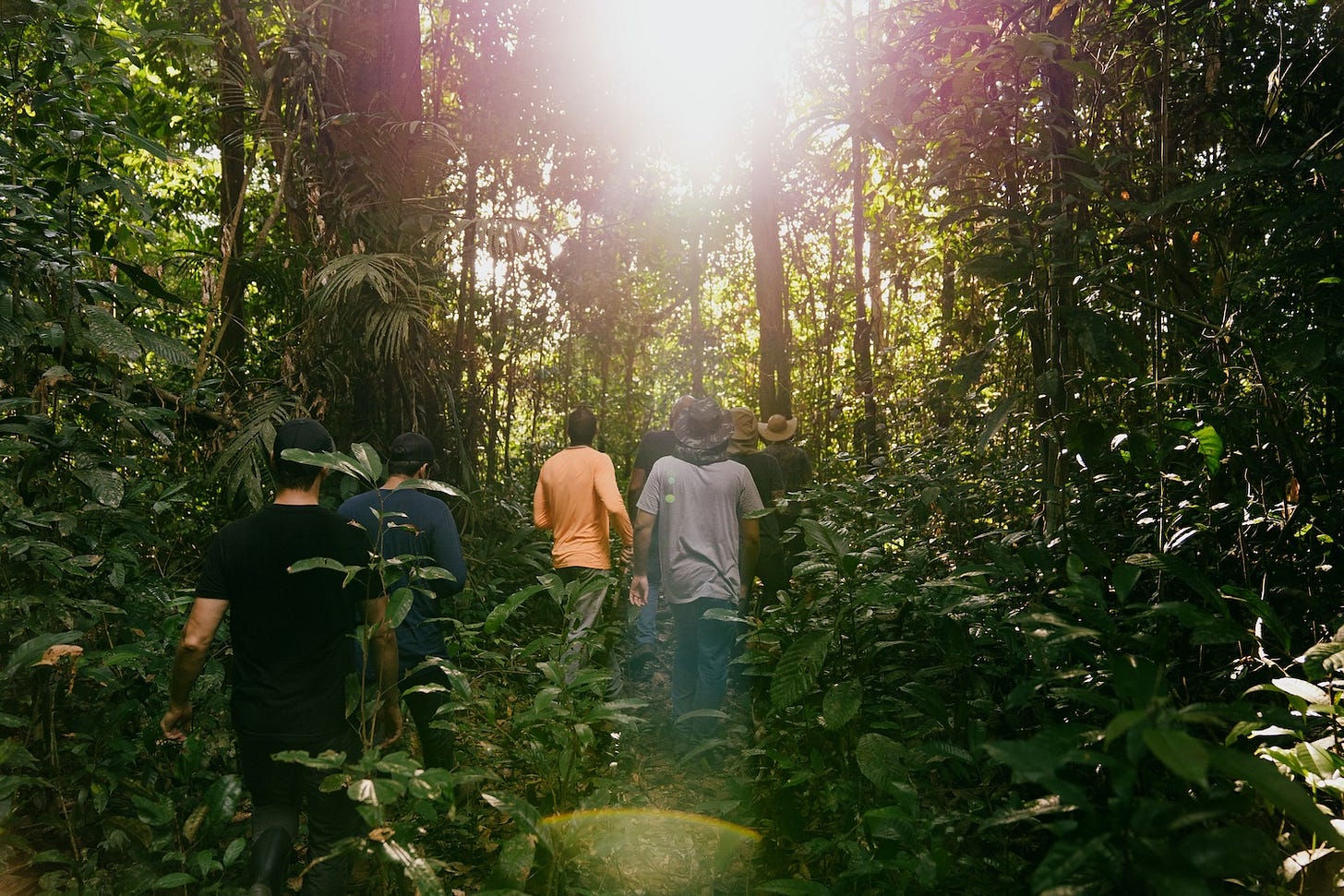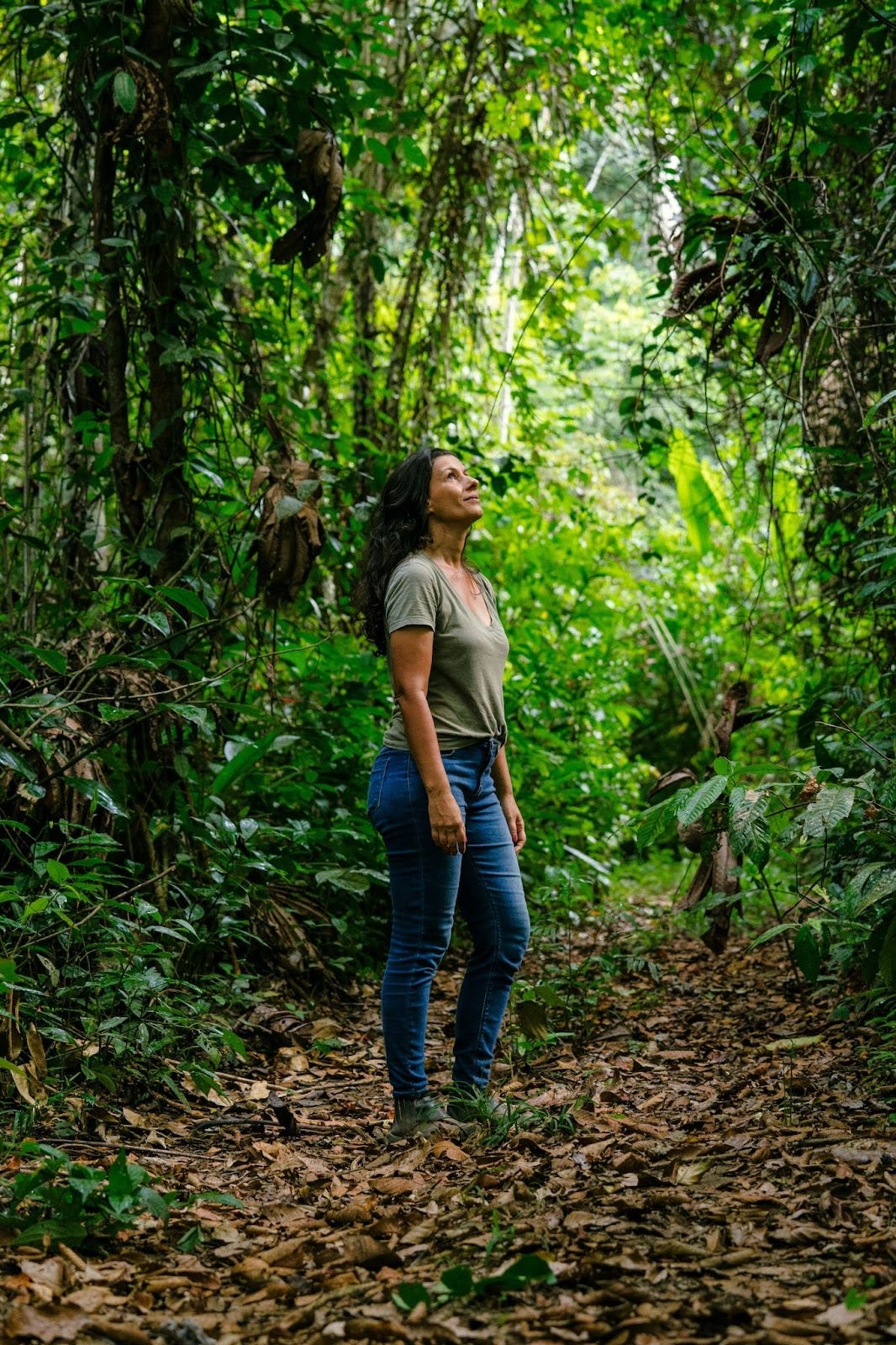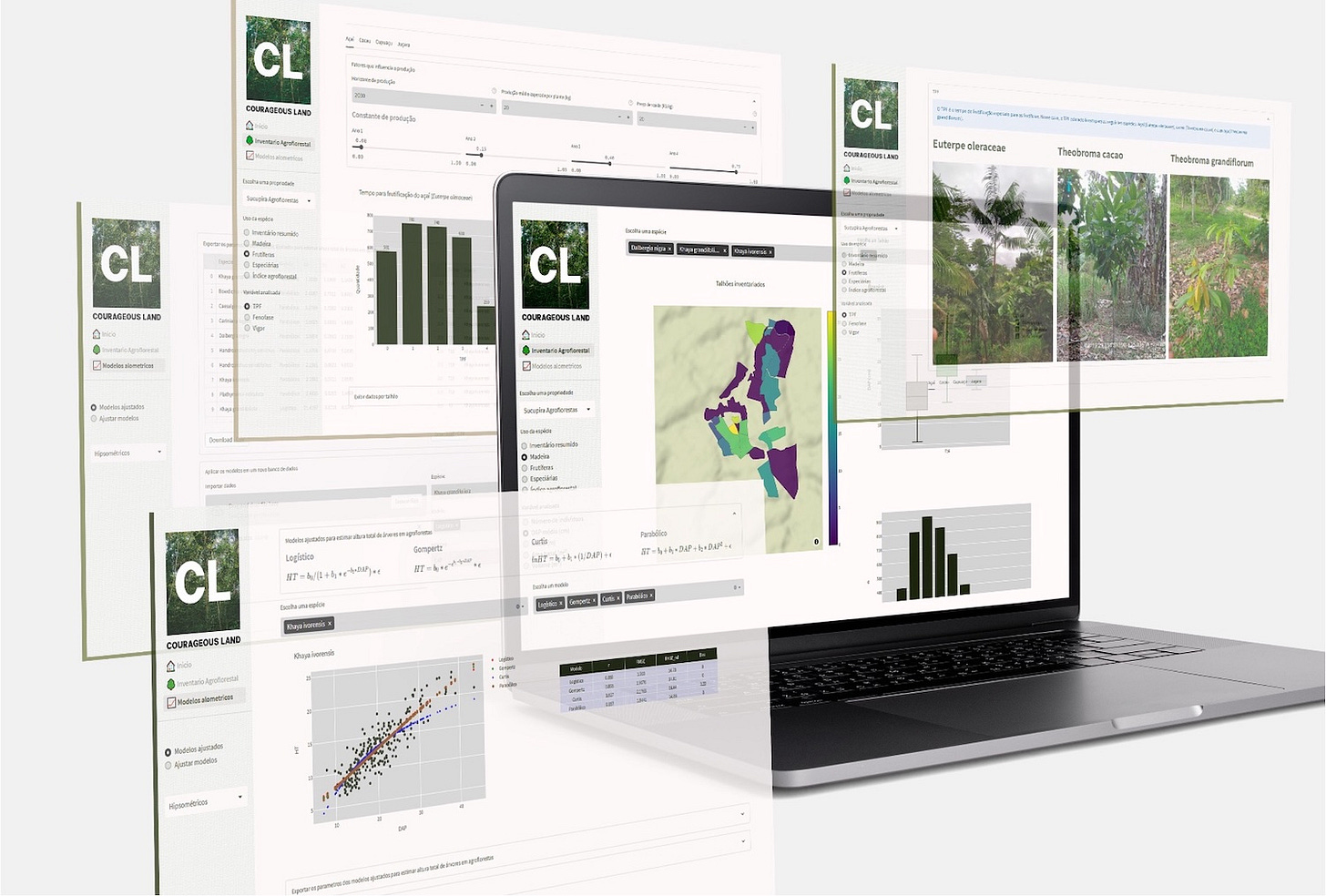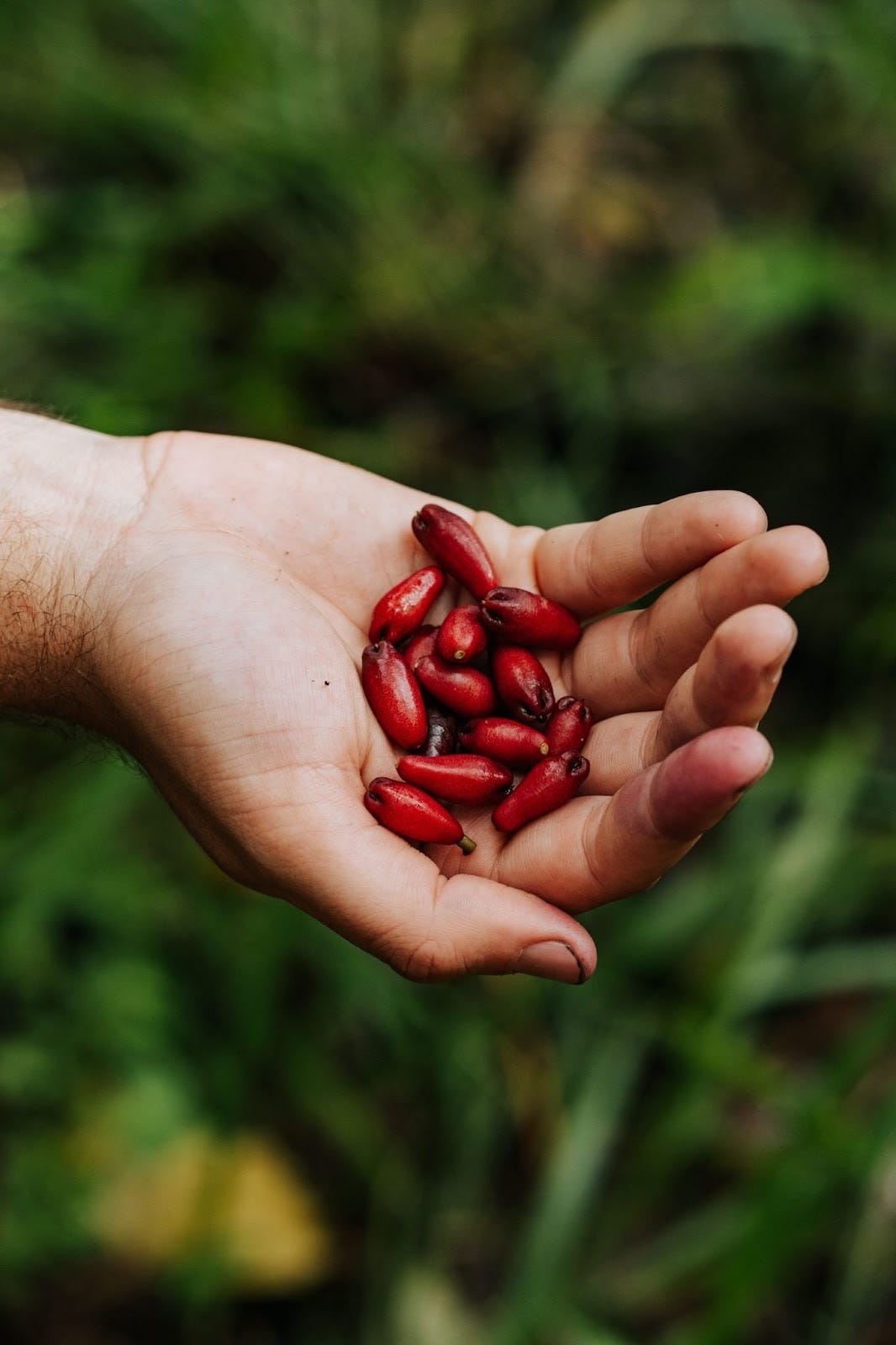What if farms behaved like forests?
Our food system is both a lifeline and a liability — it feeds eight billion people, but it’s also considered the largest threat to 86% of the world’s most endangered species.

On a hillside in Brazil, coffee saplings grow in the dappled light beneath fruit and timber trees. What first appears to be a forest is actually a farm — strategically designed to be layered, abundant and resilient. The air is cool, buzzing with insects and birdsong. The soil is alive, held together by intricate root systems.
Most modern farms are far more orderly than this one, with neat rows of crops harvested in cycles designed for consistency and scale. These industrial systems have grown alongside population growth and support millions of livelihoods. But they also come with trade-offs: depleted soils, declining biodiversity, and increasing vulnerability to both pests and climate shifts.
Our food system is both a lifeline and a liability — it feeds eight billion people, but it’s also considered the largest threat to 86% of the world’s most endangered species.
But what if industrial farms brought back some complexity? If more farms looked like the above example from Brazil, could we feed a growing population while alleviating pressure on endangered species? Courageous Land co-founder and CEO Philip Kauders believes so. Even with a growing population, he says it’s possible to feed people more sustainably by transforming how we use land that’s already available for farming, all while boosting biodiversity, actively removing carbon from the atmosphere and restoring habitat for wildlife.
The combination of agriculture and trees
Courageous Land is a platform designed to help farmers transition from monoculture to tropical agroforestry — and, in the process, to regenerative food production.
Agroforestry is the combination of agriculture and trees — a combination that can take many forms. Courageous Land’s agroforestry systems are designed with biodiversity in mind, incorporating 7-10 species of varying heights to mimic a natural forest. This creates an ecosystem that sequesters carbon, cycles nutrients and enriches soil, physically protects crops from extreme weather, regulates microclimates and naturally deters pests.
Our agroforestry systems also make the most of each square metre, Philip explains. It’s like an apartment building, he says. “You’ll have coffee or cacao on the ground floor, for example, then palm trees or fruit trees on the first floor, and timber species on the top floor.”
For farmers, agroforestry systems often increase food security, diversify income streams, and boost resilience against price shocks and extreme weather. But agroforestry is also inherently complex — and for those transitioning from industrial farming, this complexity, the opportunity cost and the price of inputs and labour is often too high of a barrier.
That’s where Courageous Land comes in.
“People believe agroforestry is so context-specific it could never be digitised. That’s not true. There’s a formula, and there’s a process. But that’s something only a tech platform can offer,” Philip says.
How Courageous Land is scaling agroforestry
Philip and his co-founders Gilberto Terra and Luiza Avelar have designed Courageous Land’s platform to remove the four main bottlenecks in agroforestry adoption: understanding a site’s potential, planning and financing, system management and generating revenue through the sale of crops and carbon.
Right now, the platform is available to farmers in Brazil working on deforested and degraded land where forests once stood tall. But the founders intend to scale throughout South America and beyond.
1. Understanding the site’s potential
The first step is a ‘diagnosis’ — a rapid, free analysis that tells landholders how many hectares are suitable for agroforestry, which species are likely to thrive, and how much income the system might generate. The platform uses modelling that accounts for soil, groundwater, local biodiversity and projected climate conditions through to 2040.
“This is a farmer's first look at what an agroforestry system could look like,” Philip says. “This process used to be expensive and took a couple of months. We can make it happen in 30 seconds, for free.”
In this step and beyond, usability is key, Philip explains. Because “if it doesn’t work for farmers, then it won’t work for nature”.
2. Planning and financing
Next comes financial planning and detailed modelling — including 3D simulations of how the farm will evolve over time. While yields of the main crop may dip at first, total output often grows over time as diverse crops mature. With stronger resilience and more income streams, these systems can set farmers up for greater long-term stability.
Still, the upfront cost is a barrier. Most farmers need outside capital to implement systems and weather the income dip during transition — but many banks are wary of agroforestry’s complexity. “Banks will finance a cornfield, but they’re unlikely to understand the complex financial model that comes with agroforestry,” Philip explains. “There are not a lot of traditional investors that invest in agroforestry.”
To solve this finance gap, Courageous Land connects farmers with project investors, impact funds, banks expanding their green portfolios and philanthropic capital — unlocking funding that would otherwise be out of reach.
3. System management
Courageous Land’s platform then offers monitoring and data analysis, allowing farmers to track water, soil health, plant health, carbon and biodiversity. But there’s also a human side: a network of expert advisers who support farmers in managing their agroforestry systems.
Agroforestry is a traditional and ancient practice, and it requires a diverse set of skills, Philip explains. Right now, farmers can call on Courageous Land’s own specialists. But Philip envisions a future where farmers can connect with a global network of vetted and certified experts. “We’ll have people on the platform who are general agroforestry specialists, as well as specialists in particular crops, machinery and equipment, or diseases and pathogens,” he says.
4. Generating revenue
Selling multiple crops to multiple buyers is the final bottleneck, which Courageous Land’s marketplace tackles by matching farmers with “mission-aligned” brands and businesses seeking nature-positive ingredients.
All goods are fully traceable and certified too — and that’s an important part of the value proposition. In December 2025, the European Union’s Regulation on Deforestation-free Products will come into effect, mandating that certain products consumed within the EU — including beef, wood, cocoa, soy, palm oil, coffee and rubber — must not contribute to the destruction of forest ecosystems. Meanwhile, corporate climate reporting is now mandatory in many countries. As more farm emissions become public knowledge, “large buyers will shift to agroforestry,” Philip says. “These goods are carbon-negative, and that’s what their customers will demand.”
Courageous Land earns a commission when crops are sold, experts are hired, or funding is secured. “If we add value,” Philip says, “we take a small slice of that value.”
The case for carbon credits and timber
Farmers on the platform can also generate income from carbon credits and timber.
Carbon credit projects have faced significant and valid criticism in the past five years, however, once those markets are supported, selling credits as part of an agroforestry model can be an “absolute game changer” for rural farmers and their communities, Philip says.
Many well-designed agroforests are carbon-negative, which means farmers are already doing this work. It’s about ensuring they are rewarded for it, Philip explains. Carbon credits place a little more power in the hands of the farmers protecting and regenerating forest ecosystems.
High-quality timber is another important source of revenue. Given the startup’s mission is reforestation, cutting down trees might sound a little counterproductive — but when done selectively, in a continuous cover system, harvesting select trees can enhance forest health and keep carbon locked in, Philip explains.
“We do continuous cover forestry,” he says. “We plant a number of fruit trees alongside timber species with different maturation rates — some of those timber trees will have mature wood after 18 years, others after 30 years, and others after 50 years. We will selectively harvest one or two trees every couple of years, and then continuously replant, so once a forest returns, it remains a forest.”
The harvested timber is then used in long-duration wood products, construction materials and furniture, Philip says, ensuring the carbon remains locked away for decades. Meanwhile, a new sapling can take root in the same spot, and so sequestration of carbon continues.
How agroforestry creates job opportunities
Courageous Land launched in 2022. Today, hundreds of farms are using the platform, with tens of thousands of hectares in the pipeline.
Wedgetail invested in Courageous Land as they have a strong founding team and a clear mission to scale agroforestry as a solution that supports nature, business and people. Philip’s 10-year goal is to help restore 100,000 hectares, starting in Brazil and then expanding internationally. “This has never been done before. But looking at our pipeline, and the conversations we’ve been having, it’s a feasible stretch goal,” he says.
In the longer term, Philip envisions landowners from all over the world operating agroforestry systems on farms large and small, creating livelihood opportunities and fuelling local economies.
Agroforestry is, as Philip Kauders puts it, “a massive opportunity.” But it’s not a one-size-fits-all solution. It won’t be suitable for every farm, or every farmer. But agroforestry doesn’t need to be universal to be transformative. It can be adopted in degrees. It can inspire other innovations. And it can serve as a reminder that what’s good for nature’s ecosystems can also be good for business.
The idea that environmental restoration must come at the cost of economic opportunity is a tired binary. “Agroforestry creates income and job opportunities that wouldn’t otherwise exist,” Philip says.
For Wedgetail, investing in Courageous Land is part of a wider commitment to unlocking financial models that support both ecological restoration and community resilience.
“This isn’t a charitable endeavour," Philip says. It’s about making regeneration viable at scale. “Agroforestry has already got a foothold, thanks to philanthropic capital. Now that it’s able to be funded by mainstream pools of capital, this foothold will scale. Just like energy needs to shift to renewables, land use for food production needs to shift to agroforestry and regenerative agriculture.”
Simplifying to enable complexity
Most technology tools are designed to reduce friction: packages arrive at our doors, apps give us directions, algorithms serve us content. In many cases, the result of this simplification is an increasingly simplified world — one with fewer distinctions, surprises and inconveniences.
We build tools to help us navigate complexity — and in the process, we often erase it.
But the Courageous Land platform operates a little differently. The platform bridges the gap between human cognition and complex natural systems. The platform simplifies, but the result is actually more complexity. At first glance, this might seem like a small distinction. But we believe it’s an important one.
We often hear that humans aren’t equipped to think in systems — that our linear, binary brains are to blame for many of today’s ecological and societal challenges. We also hear that technology, by removing friction and accelerating feedback, is compounding these challenges. There is, of course, much truth to both these statements. But that doesn’t mean they can’t be overcome or avoided.
Courageous Land’s platform reminds us that we can use technology not to flatten complexity, but to illuminate it. Not to reduce choice, but to deepen understanding. Not to dominate nature, but to align with it. Because complexity isn’t a flaw to fix — it’s a strength to work with. Because variability and biodiversity are the foundations of resilience, regeneration and life itself.
This article was written by: Bronte McHenry & Stephanie Palmer-Derrien
And edited by: Julia West, Karina West, Lisa Miller, Michael Honey and Summer Allen
All images credited to: Courageous Land
Wedgetail’s mission is to conserve and restore biodiversity through sustainable investment. We do this by providing financial capital — nature-linked loans, grants and equity investments — to organisations that put biodiversity at the heart of their business models.
If you’re on a nature-positive journey, please get in touch, as we’d love to support you.
And to follow more of our work on the ground, please subscribe to The Quoin’s newsletter.












Having just tried to find our more information of CL in regard to wildlife, browsing animals, livestock co-management, is there any formation about how the CL Farm Forests go about meat trade, say from deer or other browsing animals is approached.
In ProSilva style holistic forest management for example, the responsible management of wildlife and hunting and meat trade are part of the vegetation management, for many decades... Training and education are obviously part of this ...
Thank you for sharing about the work of Courageous Land! We are all saying that farmers need to change their practices to be more eco - but so much guidance and finance is needed here. Courageous Lands is exactly filling a part of this crucial gap.